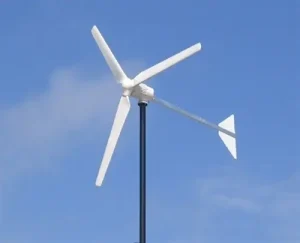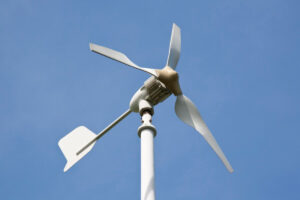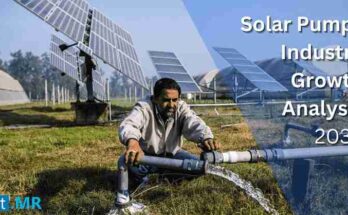The small wind systems industry is a segment of the renewable energy sector that focuses on harnessing wind power on a smaller scale. Small wind turbines, also known as “distributed wind” turbines, are designed to generate electricity for localized use, such as homes, farms, businesses, and remote locations.
These turbines typically have power capacities ranging from a few kilowatts to a few hundred kilowatts, making them suitable for smaller-scale applications. They are often installed on rooftops, towers, or standalone structures, taking advantage of available wind resources at the specific location.

The small wind industry encompasses various aspects, including the design, manufacturing, installation, and operation of small wind turbines. Manufacturers develop turbine models optimized for efficiency, reliability, and noise reduction. Installation companies specialize in the proper placement and setup of turbines, considering factors like wind speed, local regulations, and structural requirements.
- According to the Department of Energy in the United States, small wind systems are used to reduce the amount of electricity by 50% to 90%. They are also helpful for avoiding the higher investment in various other applications that include water pumping on ranches and farms.
- The global small wind market is valued at US$ 1.21 billion in 2023 whereas, it values to reach a size of US$ 3.23 billion by 2033. (Get Detailed Analytics)
- The companies focused in the report include Intertek Group PLC, Fortis Wind BV, Jacobs Wind Electric Company, Orchid International, Kliux Energies International Inc., Nerfey WindPower Company, Marlec Engineering Co., Ltd., Leviathan Energy LLC, Foshan Ouyad Electronic Co., Ltd., Energy Technology Centre Ltd., Guangzhou HY Energy Technology Limited Corp., Northern Power Systems, Inc., MOWEA GmbH, Halo Energy, and Braun Windturbinen GmbH.
The benefits of small wind energy include reduced reliance on traditional energy sources, lower electricity bills, and reduced carbon emissions. It offers a decentralized approach to power generation, allowing individuals and businesses to generate their own clean energy and potentially sell excess electricity back to the grid through net metering or feed-in tariffs.
The small wind industry also contributes to job creation and local economic development. As the demand for small wind turbines increases, it creates opportunities for manufacturers, installers, maintenance technicians, and other related professionals.
However, it’s important to note that the small wind industry faces unique challenges. The availability and consistency of wind resources can vary significantly depending on the location, which can impact the effectiveness and profitability of small wind installations. Local zoning regulations, permitting requirements, and grid interconnection policies can also influence the growth and viability of the small wind sector.
Benefits of Small Wind Systems

Small wind systems offer several benefits, including:
1. Renewable Energy Generation: Small wind turbines harness the power of the wind to generate clean, renewable energy. By utilizing wind resources, small wind systems contribute to reducing reliance on fossil fuels and mitigating climate change.
2. Energy Cost Savings: Installing a small wind system can lead to long-term energy cost savings. By generating electricity on-site, individuals and businesses can offset their electricity consumption from the grid, resulting in lower utility bills over time.
3. Energy Independence: Small wind systems provide a level of energy independence. Users can generate their own electricity, reducing dependence on the grid and insulating themselves from potential power outages or price fluctuations.
4. Environmental Sustainability: Small wind systems are an environmentally friendly energy solution. They produce no greenhouse gas emissions or air pollution during operation, helping to improve air quality and reduce carbon footprints.
5. Local Economic Development: The small wind industry stimulates local economies by creating jobs and supporting local businesses. Installation, maintenance, and manufacturing of small wind turbines require skilled labor, generating employment opportunities in the renewable energy sector.
6. Grid Support and Resilience: Small wind systems can contribute to grid stability and resilience. When connected to the grid, excess electricity generated by small wind turbines can be fed back into the system, supporting the overall electricity supply and potentially earning revenue through net metering or feed-in tariffs.
7. Remote Power Generation: Small wind systems are particularly beneficial for remote or off-grid locations. They provide a reliable and sustainable source of electricity, enabling power generation in areas with limited access to the grid or in regions where extending grid infrastructure is expensive or impractical.
8. Educational and Awareness Opportunities: Small wind systems can serve as educational tools, raising awareness about renewable energy and sustainability. They offer opportunities for individuals, schools, and communities to learn about wind power, energy conservation, and environmental stewardship.
9. Aesthetically Pleasing and Quiet Operation: Small wind turbines are often designed to be visually appealing and operate quietly. This makes them suitable for residential areas, farms, and businesses where aesthetics and noise levels are important considerations.
In conclusion, small wind systems offer numerous benefits as a clean, renewable energy solution. They provide a reliable source of electricity while reducing reliance on fossil fuels, contributing to energy cost savings, and promoting energy independence. Small wind systems also have positive environmental impacts, supporting sustainability efforts and reducing carbon footprints. Additionally, they stimulate local economies, create jobs, and offer educational opportunities. Whether for residential, commercial, or remote applications, small wind systems play a crucial role in diversifying energy sources, enhancing grid resilience, and promoting a greener and more sustainable future.
Also check: How Robotic Process Automation is Empowering the Intelligent Automation Technologies




